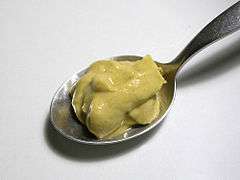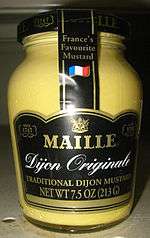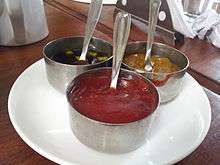Dijon mustard
Dijon mustard (French: Moutarde de Dijon) is a traditional mustard of France, named after the town of Dijon in Burgundy, France, which was the center of mustard making in the late Middle Ages and was granted exclusive rights in France in the 17th century.[1] First used in 1336 for the table of King Philip VI,[2] it became popular in 1856, when Jean Naigeon of Dijon replaced the usual ingredient of vinegar in the recipe with verjuice, the acidic juice of unripe grapes.[3]
 A teaspoon of Dijon mustard | |
| Type | Condiment |
|---|---|
| Place of origin | France |
| Region or state | Burgundy |
| Main ingredients | Mustard seeds, white wine or wine vinegar, water, salt |

The main ingredients of this condiment are brown mustard seeds (Brassica juncea)[4] and white wine,[5] or a mix of wine vinegar, water and salt designed to imitate the original verjuice.[6] It can be used as an accompaniment to all meats in its usual form as a paste, or it can be mixed with other ingredients to make a sauce.[7] The term Dijonnaise refers to a blend of Dijon mustard with mayonnaise.[8]
Commercial production
In 2008, the Anglo-Dutch group Unilever, which had several mustard plants in Europe, decided to close the Amora manufacturing plant. Since 15 July 2009 Dijon mustard is no longer manufactured and packaged in the town of Dijon, but in the neighbouring town of Chevigny-Saint-Sauveur,[9] and 80% of mustard seeds used in the manufacture of contemporary Dijon mustard come from Canada.[10] The Grey Poupon mustard brand, now well known in the United States, originated in Dijon in 1866.
Geographical indications
Dijon mustard does not have a protected geographical indication (PGI). 80% of seeds used to make the mustard come from Canada. A 1937 decree ruled that "Dijon mustard" can be used as generic designation and has no link to a specific terroir.[11] However "moutarde de Bourgogne" has a PGI and its seeds have to be produced in Bourgogne.[12]
See also
References
- Carrier, Robert (1981). Robert Carrier's Kitchen. London: Marshall and Cavendish. p. 2377.
- "The Dijon Mustard". Regions of France. Retrieved 18 May 2016.
- Jack E. Staub, Ellen Buchert (18 August 2008). 75 Exceptional Herbs for Your Garden. Gibbs Smith. p. 170.
- Lund, B.; Baird-Parker, T.C.; Gould, G.W. (2000). Microbiological Safety and Quality of Food. The Microbiological Safety and Quality of Food. Springer. p. 823. ISBN 978-0-8342-1323-4. Retrieved 4 June 2016.
- "The Difference Between Dijon and Yellow Mustard". fitday.com.
- "Just don't call it French mustard". connexionfrance.com. January 2009.
- Blumenthal, Heston. "The Essential flourless Mustard Sauce". Masterchef Australia. Tenplay. Retrieved 19 May 2016.
- "* Dijonnaise (Gastronomy)". en.mimi.hu. Retrieved 19 May 2016.
- Manzella, Luisa (13 July 2009). "Amora Dijon ferme définitivement ses portes après deux siècles d'activité" (in French). Retrieved 18 May 2016.
- "La moutarde de Dijon vient du Canada". www.journaldunet.com (in French). Retrieved 2016-05-18.
- Figaro, Madame (2018-02-22). "Camembert, moutarde de Dijon, jambon Aoste, champignons de Paris... 7 "faux" produits du terroir passés au crible". Madame Figaro. Retrieved 2019-05-15.
- "Fiche produit". www.inao.gouv.fr. Retrieved 2019-05-15.
External links
| Wikimedia Commons has media related to Dijon mustard. |
- Techniques actuelles de fabrication de la moutarde (in French) – "Contemporary method for the manufacture of the mustard"
